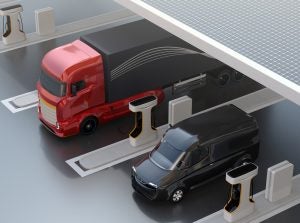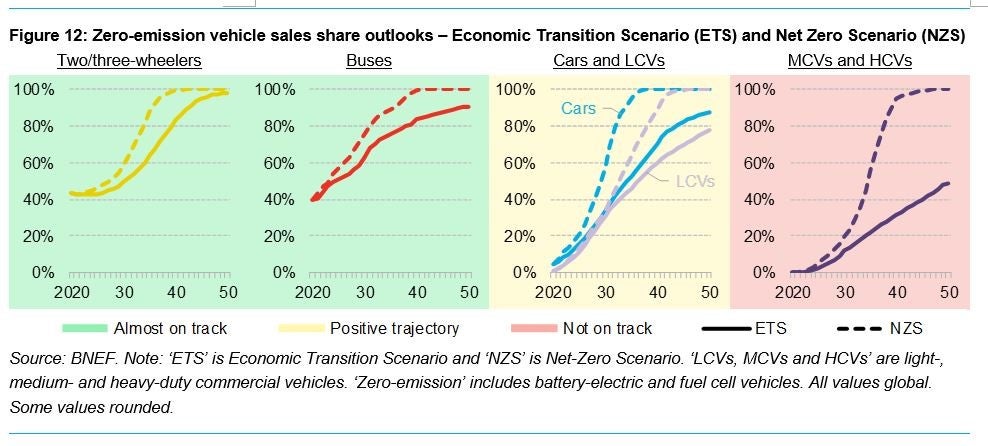 A recent report from Bloomberg New Energy Finance highlights the urgent need for policymakers to prioritize truck electrification, which could have sweeping benefits for the climate, public health, and American jobs. The annual EV outlook includes (for the first time) a comparison of the zero-emission vehicle adoption path needed to achieve net-zero by 2050, as well as a business-as-usual scenario where fleet operators continued to externalize the health and climate damage from operating combustion trucks.
A recent report from Bloomberg New Energy Finance highlights the urgent need for policymakers to prioritize truck electrification, which could have sweeping benefits for the climate, public health, and American jobs. The annual EV outlook includes (for the first time) a comparison of the zero-emission vehicle adoption path needed to achieve net-zero by 2050, as well as a business-as-usual scenario where fleet operators continued to externalize the health and climate damage from operating combustion trucks.
For large trucks and buses, the difference between these scenarios is stark. According the BNEF summary, “by 2040, zero-emission medium and heavy commercial vehicles are 95% of sales in our Net Zero Scenario, but just 30% in the ETS. This represents an ‘adoption gap’ of 65 percentage points in 2040.”
EDF has called for air pollution standards that ensure all new medium and heavy-duty trucks and buses sold are zero-emission by 2040; and that standards drive deployment of new zero-emitting solutions used in urban and community applications by 2030, noting the massive benefits such an outcome would provide. The BNEF modeling further illustrates the need for bold policy to accelerate the adoption of these vehicles.
Scaling the adoption of zero-emission heavy-duty vehicles will require a suite of polices at national, state and local levels. These policies complement each other by driving manufacturer investment into ZEVs, spurring the development of the necessary charging infrastructure; supporting the domestic manufacturing base to build these trucks and their parts; and deploying zero-emission solutions first and foremost to drive down air pollution within the communities most burdened with diesel trucks.
Leadership, bold action needed to scale electric trucks and buses Share on XHuge opportunity on the federal level
The federal government has a unique opportunity to supercharge the adoption of zero-emission trucks and buses. It’s critical that the Biden administration embrace a new generation of multi-pollutant emission standards that drive down harmful emissions and recognize the viability of zero-emission solutions. Additionally, Congress should make a significant investment in zero-emission trucks and buses. It has numerous opportunities to do this, including several key provisions in the Clean Energy for America Act recently introduced by Sen. Ron Wyden.
State and local action is also critical
States have an important role to play, too. Over a dozen states have come together and embraced the need to transition to zero-emission trucks and buses. New Jersey is at the front of this effort in considering a range of policies, including the Advanced Clean Trucks program. And California has been leading the discussion on the developing of charging infrastructure to support electric trucks and buses.
Local action is also critical. The indirect source rule, recently adopted by the California’s South Coast Air Quality Management District, is a powerful example of how local and regional agencies can drive diesel pollution reductions in their communities. The recent decision by the Montgomery County Public Schools in Maryland to partner with Highland Electric Transportation is another example of how local agencies can drive action.
Zero-emission trucks have arrived and are fully capable of performing the work needed of them. Fleets are increasingly recognizing that zero-emission trucks are the future and are setting transition timeframes and targets. Freight shippers are making clear their interest in hiring zero-emission trucks and willingness to be part of the solution that gets more of these trucks on the road. The urgent need to address the health impact from these vehicles is clear, too.
What is lacking is policy leadership. Now is the time for policymakers to embrace bold action and transition large trucks and buses to zero-emission solutions. Action now will maximize benefits for our health and help position the U.S. as a leader in manufacturing the trucks of tomorrow.










